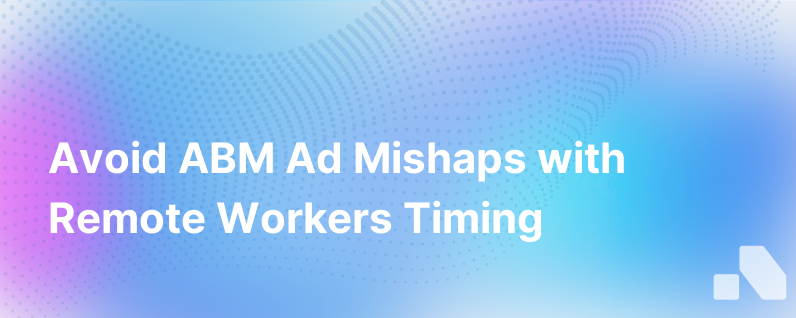Stop B2B Abm Advertising Reaching Remote Workers Wrong Time
Published on September 28, 2023 by David Zhang
In the era of remote work, many B2B marketers continue to use account-based marketing (ABM) to reach decision-makers. However, the increased prevalence of remote work cultures has necessitated a reevaluation of ABM advertising strategies, particularly regarding the timing of ad delivery. Ineffective timing can lead to wasted ad spend and missed opportunities. This article explores the challenges and strategies to optimize ABM advertising for reaching remote workers at the right time.
Adapting to the Remote Work Revolution
Remote work has changed how and when people do their jobs, meaning the 9-to-5 window is no longer a universal constant. Consequently, ABM strategies predicated on a traditional schedule risk being out of step with today’s work patterns. Here are key reasons why B2B banners might miss their mark:
- Flexibility in Scheduling: Remote workers often have flexible schedules, which means they may start their days earlier or work later into the evening.
- Variable Online Behaviors: Without the structure of an office environment, online behaviors can be more sporadic, making it challenging to predict when key stakeholders will see your ads.
- Time Zone Differences: Teams distributed across multiple time zones require thoughtful consideration as to when your messaging will be most effective.
- Digital Fatigue: The increased screen time due to remote working can lead to digital fatigue, making workers less receptive to advertising at certain times.
Understanding Remote Workers’ Online Habits
To optimize timing, it’s crucial to gain insight into the online behaviors of your target audience. Digital breadcrumbs like login patterns, email opens, and social media engagement can help construct a behavioral timeline unique to each prospect.
Data analysis from these sources can reveal opportune moments for ad delivery. For instance, an executive who typically checks LinkedIn early in the morning or a remote worker who frequents industry forums in the evening can be targeted more effectively with this knowledge.
Leveraging Technology for Timing
Technology can serve as the linchpin in delivering ads at the right time to remote teams:
- Programmatic Advertising Platforms: These platforms use machine learning to automate ad buying, crunching large amounts of data to find when specific users are most likely to engage.
- Marketing Automation Tools: Tools that track email engagement or content interaction can be synchronized with ad campaigns to ensure ads are delivered when engagement signals are strongest.
- Predictive Analytics: By employing predictive analytics, marketers can forecast the best time to capture an audience's attention based on patterns in previous interactions.
Personalizing the AD Experience
Personalization goes beyond addressing the recipient by name. It considers the person’s role, industry challenges, and personal work habits. Ads tailored in such a fine-grain manner are likely to resonate more at any given time.
- Content Matching: Ensure that ad content is relevant to the unfolding business scenario or individual professional interests to grab attention whenever the ad is seen.
- Dynamic Creative Optimization (DCO): This technique uses real-time data to adjust the creative elements of ads to align with the recipient’s recent online behavior or preferences.
Behavioral Intent Signals
The rise of intent-data platforms has enabled marketers to identify companies actively researching topics related to their products or services. By leveraging these platforms, ABM campaigns can be timed to coincide with demonstrated search behaviors.
Testing and Optimizing for Time-Based Engagement
Testing remains key to all marketing initiatives. ABM is no exception:
- A/B Testing for Timing: Run campaigns at different times to see how engagement trends.
- Continuous Monitoring and Iteration: Use analytics to monitor campaign performance and refine the timing based on data-driven insights.
- Surveys and Direct Feedback: Don’t shy away from asking your audience directly when they are most likely to engage with industry-related ads.
Stronger Integration with Sales
Sales teams can offer a wealth of knowledge regarding the best times to reach prospects. Integrating closely with sales and sharing insights can help marketing better synchronize ABM advertising efforts with prospect communication preferences.
Responsible and Respectful Advertising
As work and home life become increasingly blurred, it's important to advertise in a way that respects personal boundaries. This means not overwhelming remote workers during their downtime or late hours, regardless of how flexible their schedule might be.
Conclusion
Optimizing ABM ad timing for remote workers involves navigating their individual schedules, preferences, and behaviors. Understanding these nuances enables B2B marketers to resonate more deeply with their audience, making every ad impression count.
The pivot to remote work provides both challenges and opportunities for B2B marketers. By respecting the new normal of remote workers’ schedules, embracing technology for precise ad timing, and aligning closely with sales, B2B marketers can ensure their ABM strategies are both considerate and effective. The art and science of ABM advertising in the remote era inherently involves timing your message as thoughtfully as you craft it.
As we advance, ABM campaigns must become smarter and more agile. The combination of robust data analysis, empathetic marketing and strategic deployment will ensure that your ABM advertising cuts through the noise, reaching the right people at the right time without disturbing the delicate balance of their work-life integration.